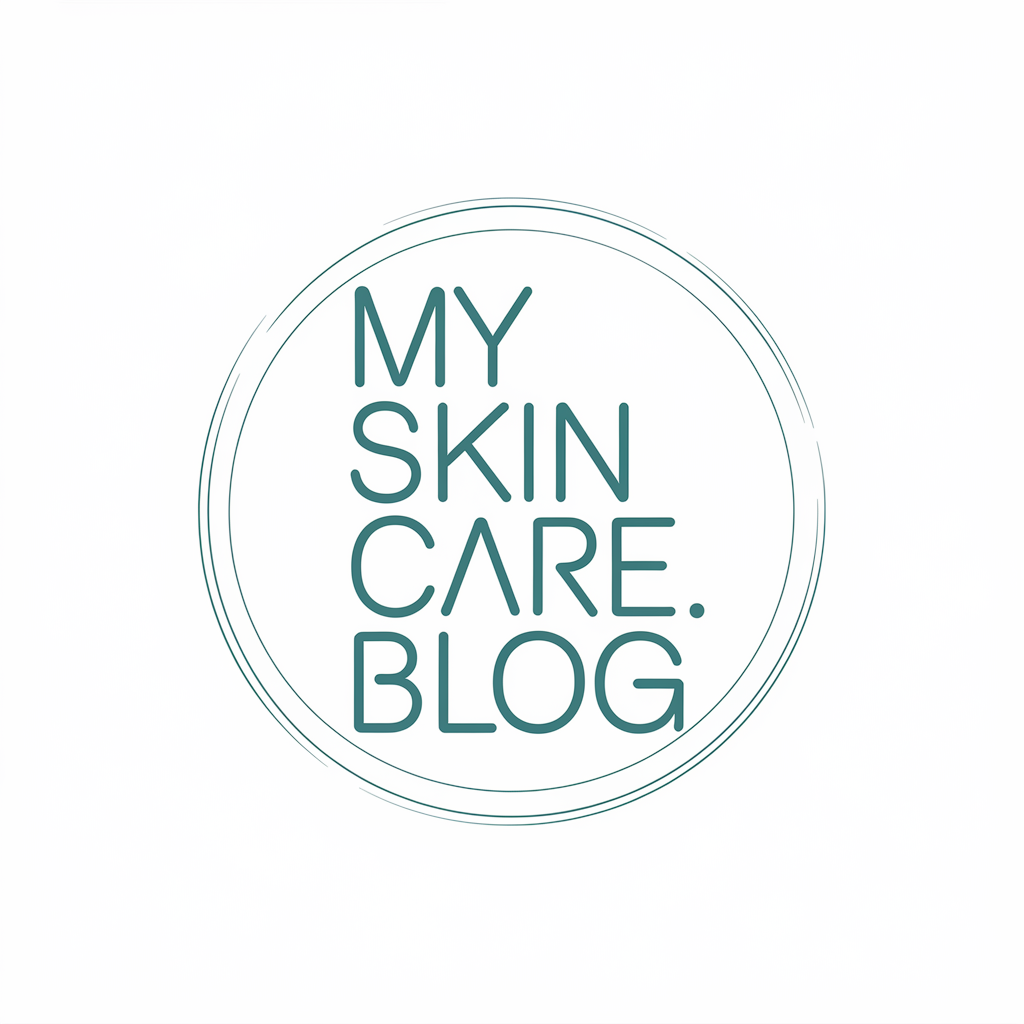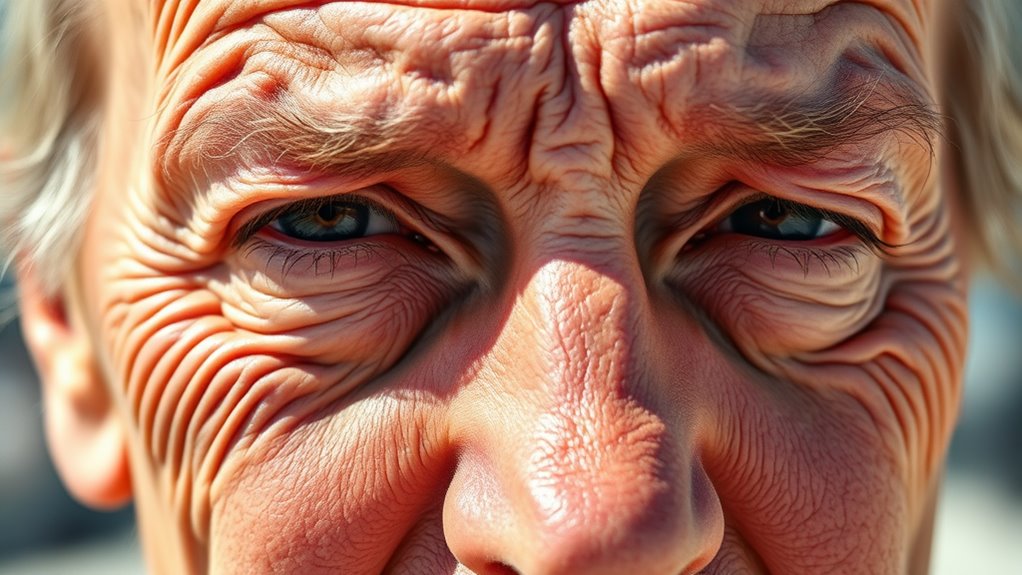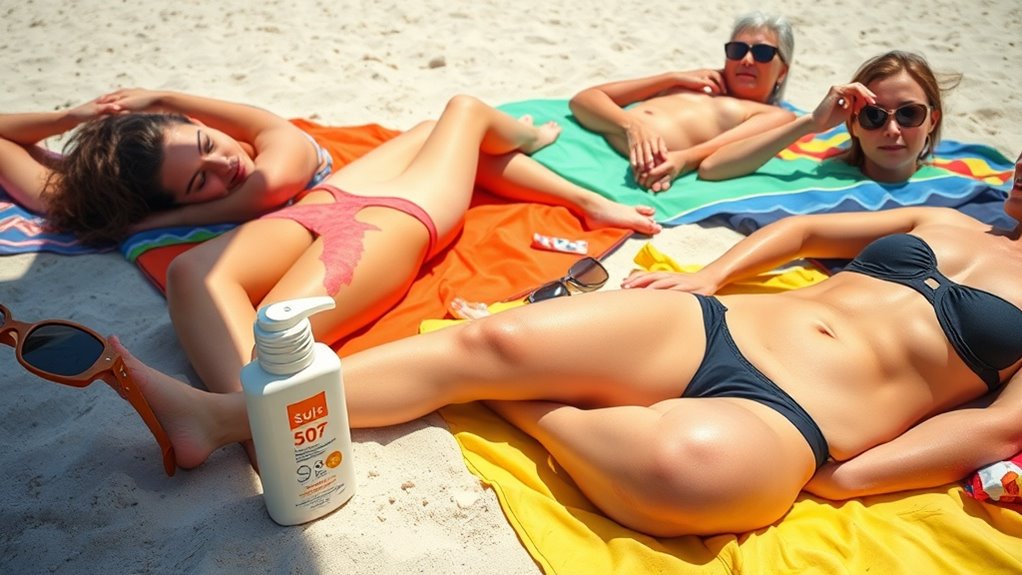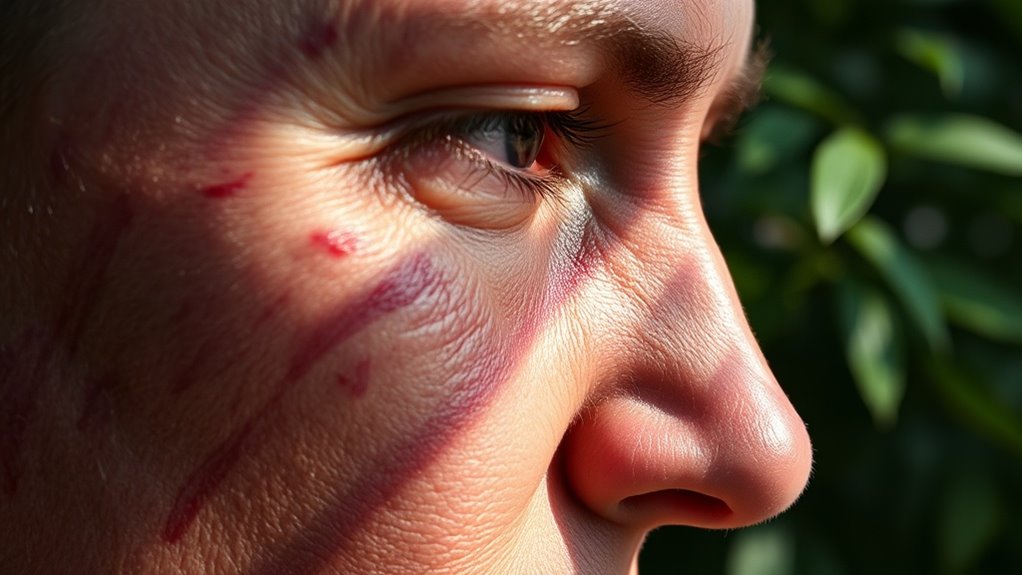Not Wearing SPF. Here’s Why Your Skin May Be Aging Faster
You’re accelerating your skin’s aging by skipping daily SPF, as UV rays penetrate deep layers, damaging DNA and breaking down collagen, which leads to premature wrinkles, sunspots, and sagging. This also boosts your risk of skin cancer, with studies showing unprotected exposure speeds up aging by up to 50%. Start shielding your skin effectively and explore proven ways to maintain its youthful resilience.
Key Takeaways
- UV rays damage skin DNA and proteins, accelerating wrinkles and sagging.
- Unprotected exposure breaks down collagen, causing premature fine lines and age spots.
- Without SPF, free radicals from UVA rays lead to oxidative stress and faster aging.
- Repeated UV exposure overwhelms skin repair, resulting in uneven pigmentation and dryness.
- Skipping daily SPF increases skin cancer risk and reduces elasticity by up to 50%.
The Dangers of UV Exposure
When you expose your skin to UV rays without SPF, you’re accelerating aging and increasing health risks.
UV radiation triggers premature wrinkles, sunspots, and a higher skin cancer risk, as confirmed by dermatological research.
The SPF importance lies in its proven barrier against these dangers; it blocks harmful rays, preserving skin elasticity and reducing photoaging effects. Additionally, sunscreen is the most cost-effective anti-aging product you can use to prevent premature skin damage.
By applying broad-spectrum SPF daily, you actively safeguard your complexion, backed by evidence from long-term studies showing lower aging rates in consistent users.
Don’t underestimate this simple defense for lasting skin health.
To optimize your skin protection, it’s essential to dispel sunscreen myths that might discourage regular use.
How UV Rays Damage Skin Cells
UV rays penetrate your skin’s layers, directly attacking DNA in your cells and triggering mutations that disrupt normal function.
Specifically, UVB rays create thymine dimers that halt accurate DNA replication, while UVA rays generate free radicals, causing oxidative damage to cellular components.
This process activates your skin’s repair mechanisms, but repeated exposure overwhelms them, leading to unchecked cellular errors.
Evidence from studies, such as those by the American Academy of Dermatology, shows UV radiation accelerates DNA breakdown, impairing cell division and protein synthesis without adequate protection.
Understanding this helps you prioritize defense against invisible threats. To further protect your skin, it’s essential to avoid toxic ingredients that can exacerbate UV damage in some skincare products.
To counteract these effects effectively, consider using a sunscreen with SPF 50 for superior protection against prolonged UV exposure.
Signs of Accelerated Skin Aging
Accelerated skin aging reveals itself through visible changes like wrinkles, fine lines, and uneven pigmentation.
You may notice sagging skin as UV rays break down collagen and elastin, leading to a loss of firmness. Research shows this also causes age spots and a rough, leathery texture that makes your complexion appear dull and aged.
Additionally, your skin becomes more prone to dryness and sensitivity, with fine lines deepening around the eyes and mouth.
These signs, backed by dermatological studies, highlight how unprotected exposure accelerates the natural aging process. To counteract this, it’s vital to dispel sunscreen myths for effective skin protection.
Furthermore, over-exfoliation can exacerbate these effects by removing essential protective layers, making skin more vulnerable to UV damage and dehydration.
Benefits of Daily SPF Use
While the signs of accelerated skin aging are clear from UV exposure, daily SPF use effectively shields your skin from harmful rays, preserving its youthful vitality. It reduces wrinkle formation, maintains collagen levels, and lowers skin cancer risk, backed by dermatological studies showing consistent application slows aging by up to 50%. Pairing daily SPF with antioxidant-rich botanicals can enhance these benefits by providing additional defense against free radicals and supporting skin repair. Moreover, combining daily SPF with lifestyle modifications can further promote radiant skin through balanced habits like diet and exercise, as part of broader anti-aging strategies. Here’s a quick breakdown:
| Benefit | How It Helps You |
|---|---|
| UV Ray Blockage | Prevents DNA damage |
| Collagen Preservation | Keeps skin firm and plump |
| Long-Term Protection | Minimizes future repairs |
Types of Sun-Induced Damage
Sun exposure without proper protection triggers several distinct types of damage to your skin, ranging from immediate burns to long-term issues like premature aging and heightened cancer risk.
For example, UVB rays cause painful sunburn, inflaming your epidermis and potentially leading to blisters.
UVA rays penetrate deeper, breaking down collagen and elastin, which accelerates wrinkles and sun spots.
Over time, this damage accumulates, increasing your susceptibility to skin cancers such as melanoma, as supported by decades of dermatological research. Furthermore, chronic stress can exacerbate skin issues by triggering hormonal changes that lead to conditions like acne.
Recognizing these effects empowers you to prioritize skin health.
To minimize these risks, it’s crucial to follow lifestyle tips that promote youthful skin.
Choosing Effective Sunscreen Products
When you select a sunscreen, focus on key ingredients like zinc oxide for broad-spectrum protection.
Understand SPF ratings to ensure at least SPF 30 against UVB rays, and follow application tips for even coverage.
Research confirms that these elements minimize UV-induced damage, preserving your skin’s elasticity and reducing aging signs.
Start by evaluating products based on these criteria to make informed choices for daily use.
It’s essential to consider your skin type when choosing sunscreen to ensure it suits your specific needs.
Moreover, to safeguard your skin further, always audit your skincare products for harmful ingredients that might counteract the protective effects.
Key Ingredients
Effective sunscreens rely on specific key ingredients to shield your skin from harmful UV rays. These components work actively to combat aging by blocking UVA and UVB radiation, backed by dermatological research.
To evoke the urgency of protection and prevent regret over accelerated aging, consider these key ingredients:
-
Zinc oxide: This mineral forms a physical barrier, stopping UV penetration that could etch deep wrinkles into your once-smooth skin.
-
Titanium dioxide: It reflects rays away, preserving your skin’s youthful glow and sparing you the emotional toll of sun damage.
-
Avobenzone: A chemical absorber targeting UVA, it guards against invisible aging, helping you maintain the confidence of healthy skin.
-
Octocrylene: Enhances stability, ensuring long-lasting defense so you avoid the heartbreak of premature aging signs.
SPF Ratings
Understanding SPF ratings is essential for selecting the right sunscreen to combat skin aging. SPF, or Sun Protection Factor, measures how well a product shields your skin from UVB rays, which cause burns and accelerate aging.
For instance, an SPF 30 sunscreen blocks about 97% of UVB rays, while SPF 50 blocks 98%, according to dermatological studies. You should always choose broad-spectrum options, which protect against both UVA and UVB rays, as UVA contributes to wrinkles and loss of elasticity.
Evidence from the American Academy of Dermatology shows that higher SPF ratings reduce long-term damage, so opt for at least SPF 30 daily to maintain youthful skin.
Application Tips
One key to protecting your skin from premature aging lies in selecting the right sunscreen products.
It’s not just about slapping on any lotion; you need evidence-based choices to shield against UV damage.
Here’s how to pick wisely and evoke the urgency of prevention:
-
Opt for broad-spectrum coverage*: Ensure it blocks both *UVA and UVB rays, sparing you the heartbreak of deep wrinkles and spots from unseen damage.
-
Choose at least SPF 30****: Dermatological studies show this level effectively halves your skin’s aging risk, preventing that premature leathery texture.
-
Select water-resistant formulas****: For active days, this keeps protection intact, avoiding the regret of faded defense during fun in the sun.
-
Prioritize mineral-based options****: Ingredients like zinc oxide offer gentle, non-irritating barriers, letting you maintain youthful radiance without compromise.
Integrating SPF Into Your Skincare Routine
Now that you’ve chosen an effective SPF product, you’ll integrate it seamlessly into your daily skincare routine by applying it every morning after cleansing.
This step protects your skin from UV damage, as studies show consistent use slows aging signs like wrinkles.
Choose SPF Product
While protecting your skin from UV rays is essential, you’ll need to select an SPF product that suits your skin type and lifestyle for effective integration.
Dermatological studies emphasize matching formulations to avoid issues like breakouts or sensitivity, ensuring long-term compliance.
To make an emotionally resonant choice, consider:
-
Shielding against aging: High-SPF broad-spectrum products combat UV-induced wrinkles, evoking fear of lost youth and motivating protection.
-
Personal comfort: Opt for non-comedogenic options for oily skin, sparking relief from irritation and boosting your confidence.
-
Lifestyle fit: Choose water-resistant formulas for active days, igniting joy in outdoor freedom without worry.
-
Health security: Prioritize products with antioxidants, stirring a profound sense of safety against skin cancer risks.
Add to Routine
As UV rays continue to accelerate skin aging and increase cancer risks, you’ll effortlessly integrate SPF into your daily routine by applying a broad-spectrum formula of at least SPF 30 every morning.
Studies from the Skin Cancer Foundation show this simple step shields against UVA and UVB rays, preserving collagen and elastin.
Pair it with your cleanser and moisturizer for seamless protection; opt for a non-comedogenic version if you have oily skin.
Dermatologists recommend checking for water resistance and antioxidants, ensuring long-term defense against premature wrinkles and spots.
Make it habitual for healthier, youthful skin.
Reapply Daily
Reapply your SPF every two hours, particularly during extended sun exposure, to sustain its protective barrier against UV damage.
This evidence-based practice integrates seamlessly into your skincare routine, backed by dermatological studies showing it reduces aging signs like wrinkles and spots.
-
Picture the heartbreak of premature aging lines marring your once-smooth skin from skipped reapplications.
-
Feel the anxiety of potential skin cancer risks, as UV rays damage DNA without consistent protection.
-
Experience the relief of maintaining your natural glow, boosting self-esteem with every layer you add.
-
Envision the pride in safeguarding your health for loved ones, ensuring a vibrant, age-defying future.
Long-Term Strategies for Skin Protection
Adopting long-term strategies helps safeguard your skin against ongoing UV damage and accelerates aging prevention.
You must integrate daily broad-spectrum SPF into your routine, as studies from the Skin Cancer Foundation show it cuts aging signs by up to 50%.
Wear UV-protective clothing and seek shade during peak sun hours to minimize exposure.
Incorporate antioxidant-rich foods like berries and greens, which research links to reduced oxidative stress.
Schedule regular dermatologist check-ups; early detection prevents issues.
These evidence-based habits ensure your skin stays healthy and resilient for years.





